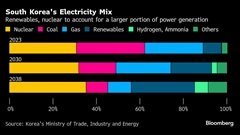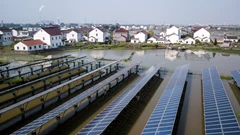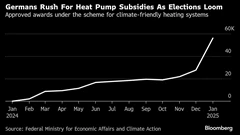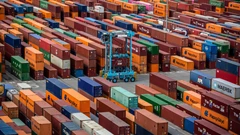Global Land Crunch Risks Sparking Conflict, Chatham House Says
(Bloomberg) -- The competing demands of the food, energy and carbon storage industries are deepening land shortages, fueling the likelihood of future conflicts as nations scramble for scarce resources, according to Chatham House.
A growing and more prosperous global population, alongside threats to soil fertility and water supplies, plus misguided approaches to capturing carbon emissions are increasing land pressures, the London-based think tank said in a report Wednesday. As a result, the world has insufficient land to hit climate and biodiversity goals, produce sufficient food and meet increasing demands for other essential goods and services, it warned.
Under one scenario for the middle of the century, there could be a global agricultural land deficit of 573 million hectares — an area almost twice the size of India. A growing land scarcity raises risks that nations with geopolitical heft will wield their soft power and economic influence to exploit the resources of other countries, Chatham House said.
“Governments in particular have to make land an urgent priority,” said Richard King and Tim Benton, the report’s authors. “They need to start recognizing and acting on the land crunch as one of the existential issues of our time.”
The researchers have developed a Land Wealth Index for 163 countries, based not only on the size of their resources, but also future risks, governance and population pressures. Some of the world’s largest countries — the US, Russia, Australia, and China — top the list, while Djibouti and Haiti come at the bottom.
The report raises questions about the ability of bioenergy to be used at scale and its pressure on global crops. The technology uses wood offcuts to replace fossil fuels like coal for stable, baseload power generation, but requires upward of 1,000 times as much land for each unit of power generated, the authors said.
Partly as a result, the report recommends that nations should cut their reliance on high-risk, unproven and extremely land-hungry bioenergy and carbon capture projects. It also advocates transforming food production and diets away from a focus on livestock, and the better use of barren and degraded lands.
Unprecedented international cooperation will be required to avert disaster, Chatham House said, recommending strengthening the enforcement of land rights and incentivizing the protection of land by financing its stewardship.
“It is also the first time since the dawn of globalization that land use is so closely entwined with geopolitics,” according to the report. “The land crunch is already a real problem for the world, and the risks associated with it are intensifying.”
©2023 Bloomberg L.P.
KEEPING THE ENERGY INDUSTRY CONNECTED
Subscribe to our newsletter and get the best of Energy Connects directly to your inbox each week.
By subscribing, you agree to the processing of your personal data by dmg events as described in the Privacy Policy.
More renewables news

GB Energy Faces New Doubts as UK Declines to Affirm Future Funds

Korea Cancels Planned Reactor After Impeaching Pro-Nuke Leader

Brazil’s Net-Zero Transition Will Cost $6 Trillion by 2050, BNEF Says

SolarEdge Climbs 40% as Revenue Beat Prompts Short Covering

EU to Set Aside Funds to Protect Undersea Cables from Sabotage

China Revamps Power Market Rules In Challenge to Renewables Boom

KKR increases stake in Enilive with additional €587.5 million investment

TotalEnergies and Air Liquide partner to develop green hydrogen projects in the Netherlands

Germany Set to Scale Down Climate Ambitions
















